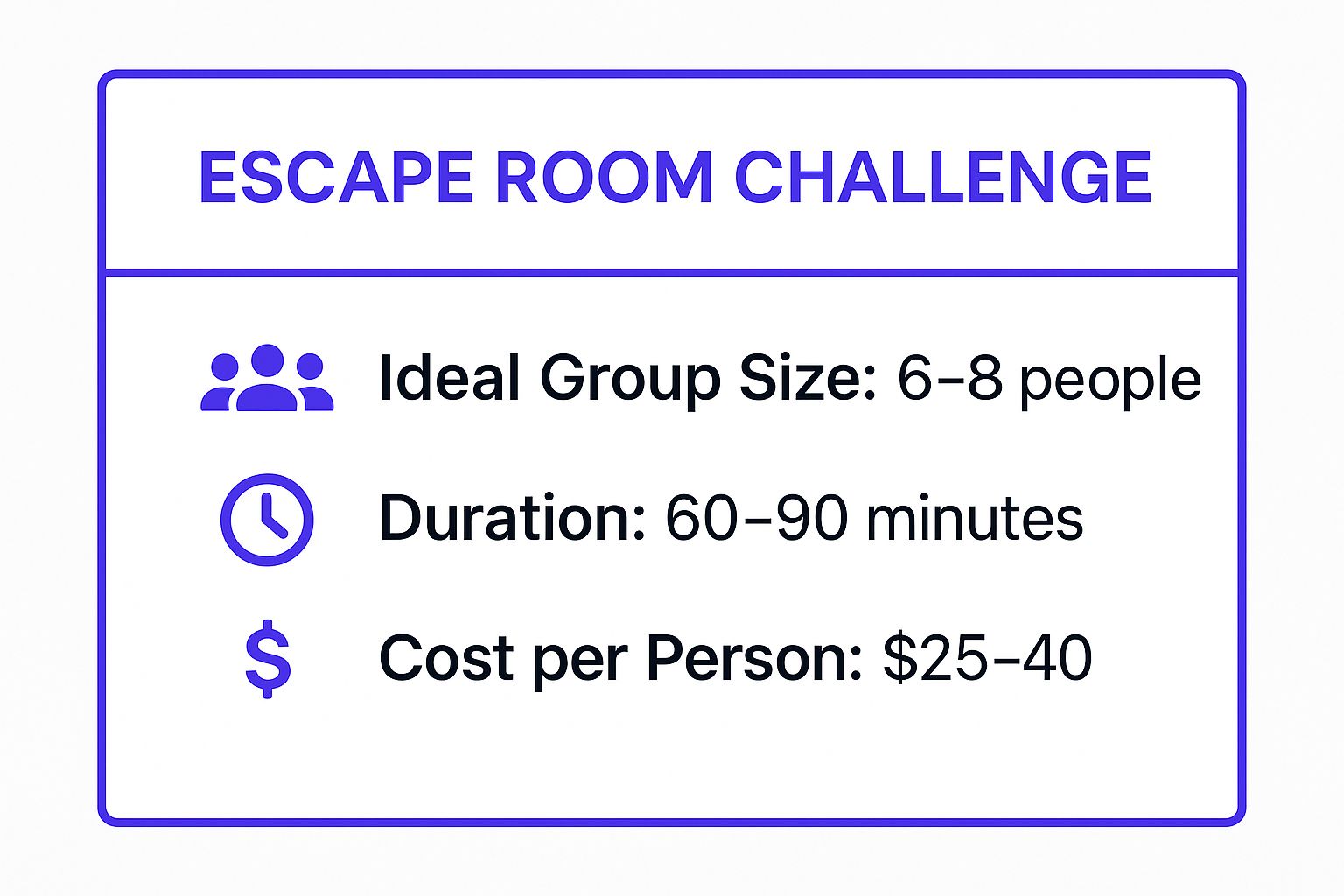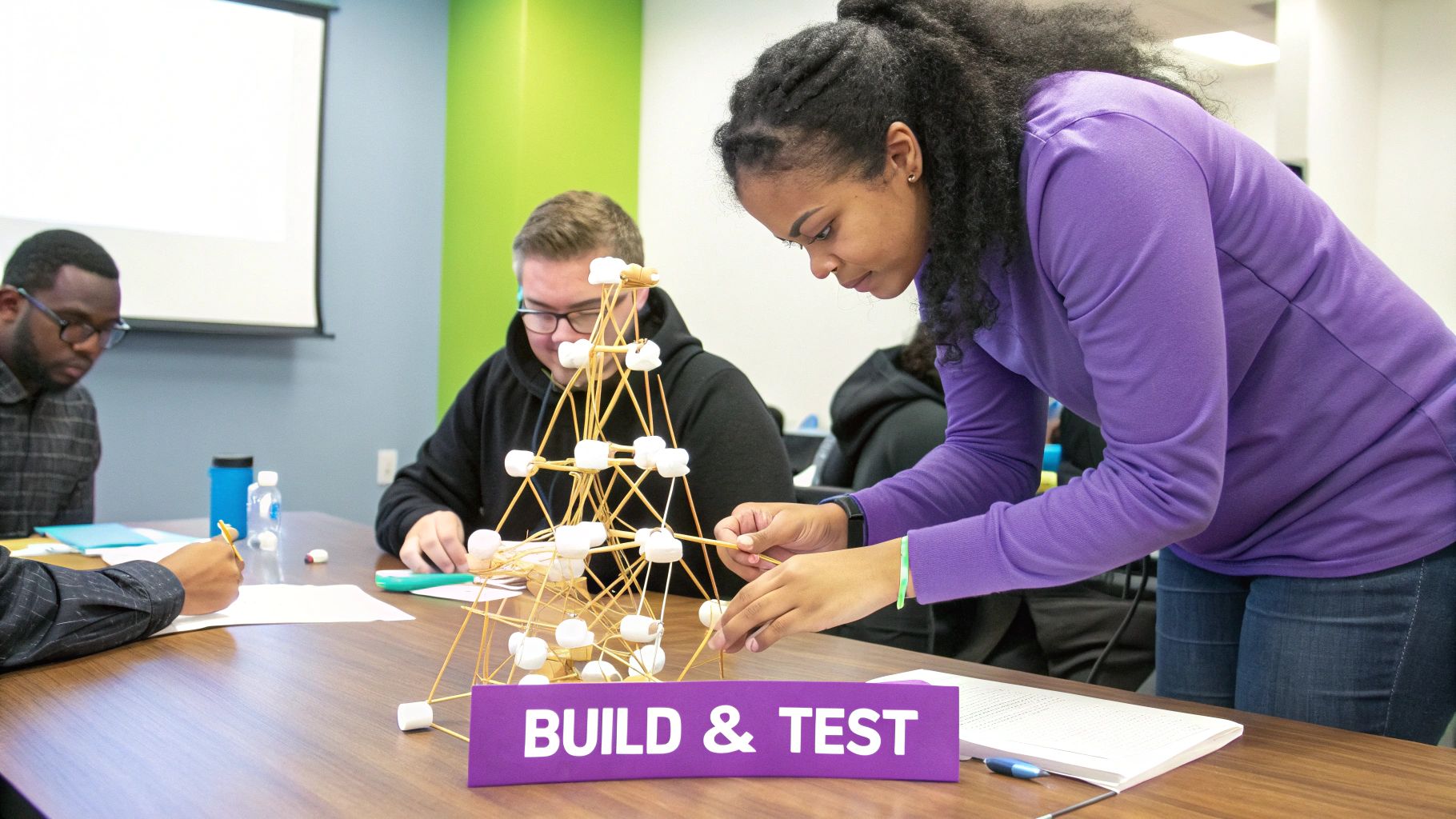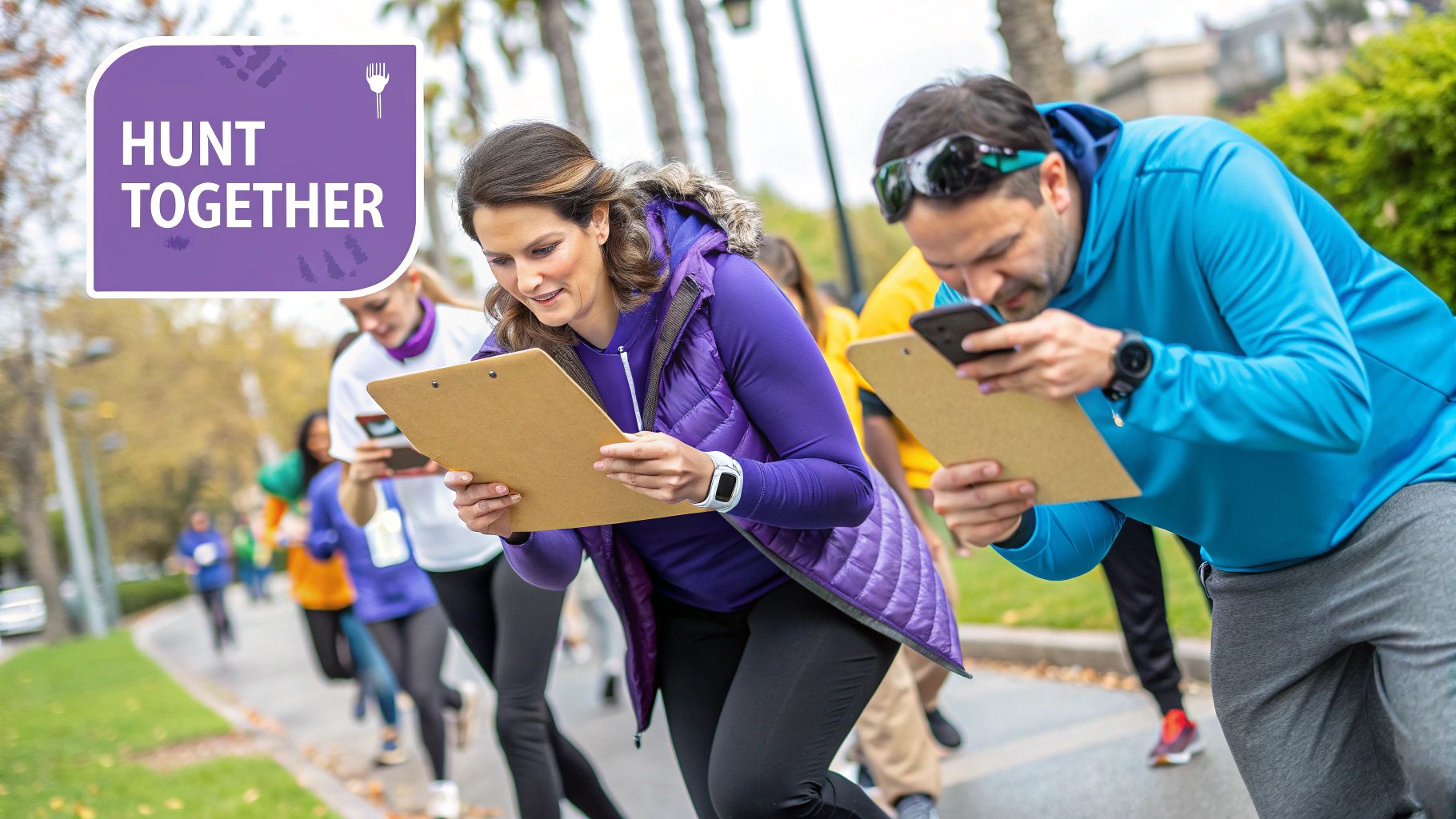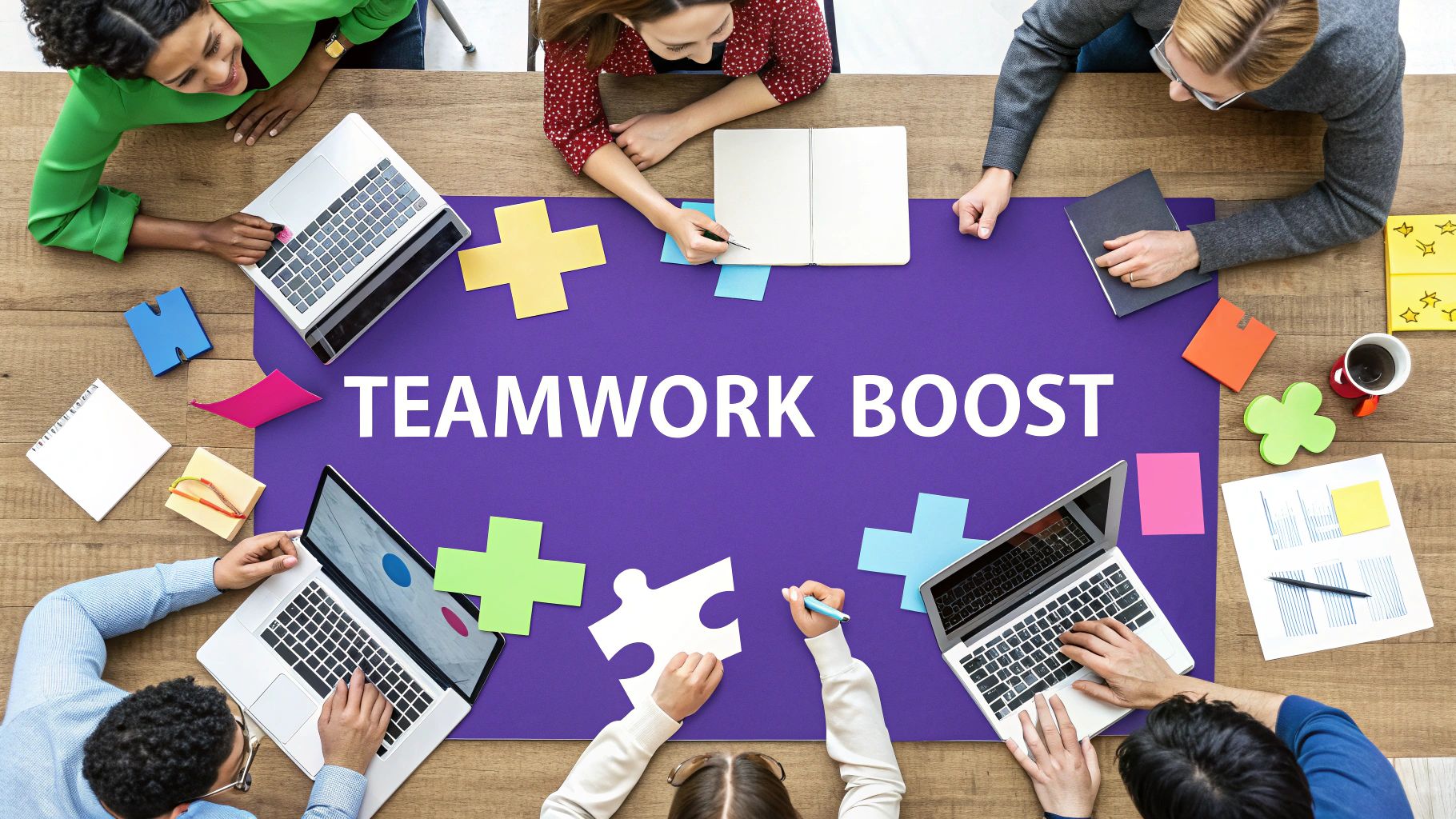In today's fast-paced work environment, genuine teamwork is the engine of innovation and success. But how do you transform a group of individuals into a cohesive, high-performing unit? The answer lies in creating meaningful shared experiences that build trust and improve communication. This guide moves beyond generic icebreakers to offer specific, actionable group activities to build teamwork.
We provide a curated list of exercises tailored for in-person, hybrid, and even fully remote teams. For each activity, we will break down the 'why' behind it, offer clear step-by-step instructions for execution, and highlight the specific collaboration skills it hones. These structured challenges are designed to reveal team dynamics, strengthen problem-solving abilities, and foster a more connected culture. Beyond formal team-building, exploring other engaging indoor activities can also foster connection and shared experiences within a group.
Whether you are a product manager aiming to align your squad, a facilitator leading a workshop, or a leader looking to energize your staff, this article provides the practical tools you need. Forget abstract theories; this is a straightforward playbook for forging stronger bonds and unlocking your team’s collective potential through hands-on collaboration.
1. Escape Room Challenge
An escape room is an immersive, real-time puzzle where a team is “locked” in a themed room and must collaborate to solve a series of interconnected challenges. The goal is to complete the objective and escape within a strict time limit, typically 60 minutes. This high-pressure environment makes it one of the most effective group activities to build teamwork, as it naturally requires communication, delegation, and creative problem-solving.
Companies like Google and Microsoft use escape rooms to accelerate bonding for new hires and develop leadership skills. The focused, time-sensitive nature of the challenge forces team members to quickly identify and leverage each other's strengths. An analytical thinker might decipher a code while a more observant colleague spots a hidden clue.
Why It Works for Team Building
This activity bypasses typical workplace hierarchies, encouraging leadership to emerge organically. Success hinges on the team’s ability to communicate clearly and manage pressure, making it a powerful diagnostic tool for team dynamics.
To help you plan your event, here is a quick overview of the typical logistics for an escape room challenge.

This data shows that escape rooms are an accessible and time-efficient option, fitting easily into a single afternoon without a major budget commitment.
How to Implement It Effectively
For the best results, plan a debrief session immediately after the challenge. This discussion is crucial for translating the experience into actionable workplace improvements.
- Mix Your Teams: Combine members from different departments to foster cross-functional collaboration.
- Focus on Process: Encourage the team to value communication and teamwork over just "winning" the game.
- Facilitate a Debrief: Ask targeted questions like, "How did we handle disagreements?" or "What communication tactic worked best under pressure?" This helps connect the activity back to daily work.
2. Marshmallow Challenge
The Marshmallow Challenge is a fast-paced design exercise where teams build the tallest free-standing structure using just 20 spaghetti sticks, one yard of tape, one yard of string, and a marshmallow. The marshmallow must sit on top, and teams have only 18 minutes. This simple task is a powerful diagnostic tool, revealing deep insights into a team's approach to collaboration, innovation, and handling pressure.

Popularized by Tom Wujec in his viral TED talk, this challenge is used by innovation leaders like Autodesk and the Stanford d.school. It powerfully illustrates the importance of prototyping and iterative design. Teams that spend time testing their assumptions and building small prototypes consistently outperform those who wait until the last minute to place the marshmallow on top. This makes it one of the most insightful group activities to build teamwork for any team focused on agile development or creative problem-solving.
Why It Works for Team Building
The activity reveals hidden team dynamics, planning fallacies, and communication styles in a low-stakes environment. It highlights the power of prototyping over rigid planning, as kindergarteners famously outperform MBA students by experimenting constantly. Success depends on shared understanding, rapid iteration, and adaptive strategy.
For a deeper dive into the setup and facilitation, you can learn more about the official Marshmallow Challenge rules and tips.
How to Implement It Effectively
The value of this challenge lies in the post-activity discussion. Focus the debrief on how the team's process mirrors real-world projects and challenges.
- Emphasize Process, Not Outcome: Celebrate the team's collaborative process, not just whether their structure stood or fell.
- Facilitate a Debrief: Ask powerful questions to connect the experience to work, such as, "What was our 'marshmallow' on our last project?" or "How did we react when our first idea failed?"
- Run Multiple Rounds: If time allows, run the challenge twice. The improvement in the second round provides a tangible lesson on the value of applied learning and iteration.
3. Two Truths and a Lie (Icebreaker Evolution)
Two Truths and a Lie is a classic icebreaker evolved into a powerful communication exercise. Each person shares three statements about themselves: two true and one false. The team then collaborates to identify the lie. This activity is one of the simplest yet most effective group activities to build teamwork because it encourages active listening, critical thinking, and genuine curiosity about colleagues.
Companies like Zappos and Buffer have integrated this activity into their onboarding and all-hands meetings to accelerate bonding. The key is to move beyond simple personal facts and focus on professional experiences or values. For example, a statement could be "I once solved a critical bug by using a Python script" or "My biggest professional failure taught me the importance of user feedback." This reframing elevates the game from a simple icebreaker to a meaningful team-building tool.
Why It Works for Team Building
This activity quickly builds psychological safety by creating a low-stakes environment for sharing. It helps team members discover unexpected commonalities and skills, fostering deeper connections and empathy. Success depends on the group's ability to analyze information and work together to reach a consensus, strengthening their collective problem-solving muscle.
How to Implement It Effectively
To maximize the impact, structure the activity with clear intentions and facilitate a brief follow-up discussion. The goal is to create authentic connections, not just to play a game. For more inspiration, explore these other group ice-breaking activities.
- Model the Way: As the facilitator, go first to set the tone and demonstrate an appropriate level of sharing.
- Set Clear Boundaries: Define whether statements should be personal, professional, or a mix to ensure everyone feels comfortable.
- Facilitate Discussion: Encourage teams to discuss their reasoning before voting on the lie. Ask questions like, "What makes you think that one is the lie?"
- Follow Up on Truths: After a lie is revealed, prompt a brief conversation about one of the interesting truths to deepen the connection.
4. Blindfolded Obstacle Course
A blindfolded obstacle course is a classic trust-building exercise where one team member navigates a path of simple obstacles guided only by the verbal instructions of their teammates. The blindfolded person must rely completely on the team's directions, making this one of the most powerful group activities to build teamwork for developing communication and trust. The setup can be as simple as weaving through office chairs or as complex as a dedicated outdoor course.
This activity is a staple in leadership training programs, including those used by the military and organizations like Outward Bound. It forces participants to practice giving and receiving precise, unambiguous instructions. Success is impossible without active listening and a shared sense of responsibility for the blindfolded member’s safety and success, creating a strong, immediate bond.
Why It Works for Team Building
The Blindfolded Obstacle Course breaks down communication barriers by removing non-verbal cues. Participants learn to articulate their thoughts with extreme clarity and to trust their colleagues' judgment implicitly. It highlights how different people interpret the same instructions, providing a memorable lesson in perspective and empathy.
To ensure a safe and impactful experience, follow these guidelines.
How to Implement It Effectively
The debriefing session after this activity is essential for connecting the experience to workplace dynamics. Discussing what communication styles were effective and where trust faltered can lead to significant breakthroughs.
- Prioritize Safety: Use soft obstacles and have designated "spotters" who can intervene to prevent falls.
- Establish Clear Rules: Instruct guides to use specific, directional language (e.g., "Take two small steps to your left").
- Rotate Roles: Ensure every team member experiences being both the guide and the blindfolded participant to build empathy and understand both sides of the communication dynamic.
- Facilitate a Debrief: Ask targeted questions like, "What specific words or phrases created the most clarity?" or "How did it feel to place your trust entirely in your team?" This helps anchor the learnings back to project collaboration.
5. Human Knot
The Human Knot is a classic physical problem-solving challenge that serves as a powerful metaphor for untangling complex workplace issues. Team members stand in a circle, reach across to grab the hands of two different people, and then must communicate and cooperate to unravel themselves into a single, untangled circle without letting go. This activity is a standout among group activities to build teamwork because it physically embodies the need for clear communication and patience.
This exercise is a staple in experiential education and is often used by tech companies during hackathon team formations and by schools in leadership classes. The immediate, tangible goal forces participants to work together closely, breaking down personal space barriers and encouraging creative, hands-on problem-solving. Success is impossible without everyone's full cooperation.
Why It Works for Team Building
The Human Knot requires participants to navigate a shared physical problem, fostering a unique sense of shared accomplishment. It highlights the importance of every individual's role and how one person’s movement affects the entire group. Leadership and strategic thinking often emerge organically as the team tests different solutions.
How to Implement It Effectively
Before starting, ask everyone to remove watches or jewelry to ensure comfort and safety. The debrief is key to linking the physical challenge with organizational challenges.
- Form Small Groups: Keep circles to 8-12 people for the best results. For larger gatherings, create multiple competing knots.
- Encourage Vocal Strategy: Prompt the team to talk through their moves before acting. Ask questions like, "Who feels a pull?" or "What's the next logical step?"
- Facilitate a Debrief: After they untangle (or time runs out), discuss the experience. Ask, "What communication strategies worked best?" and "How does this relate to the complex 'knots' we face in our projects?" to connect the activity back to the workplace.
6. Collaborative Jigsaw Puzzle Race
A collaborative jigsaw puzzle race transforms a classic pastime into a dynamic team-building exercise. In this activity, teams must complete a puzzle, but with a twist: essential pieces are mixed and distributed among competing groups. This setup forces teams to negotiate, trade, and collaborate with their rivals to succeed, highlighting the importance of inter-team communication and resource sharing.
This activity is a staple in corporate training because it physically represents how individual and team contributions fit into a larger company goal. For instance, consulting firms like Accenture use large-scale puzzle exercises at leadership events to train project managers on resource allocation and negotiation. The challenge reveals how hoarding information or resources can lead to collective failure, even if one team gets ahead temporarily.
Why It Works for Team Building
This is one of the most effective group activities to build teamwork because success is impossible without cooperation. It breaks down silos and encourages a "bigger picture" mindset, showing that sometimes you must help a competing department to achieve a shared organizational objective.
The activity serves as a powerful metaphor for cross-functional projects where different teams hold different "pieces" of the puzzle, such as data, expertise, or budget. It's a low-pressure way to practice negotiation and also serves as one of several engaging creative thinking exercises for groups.
How to Implement It Effectively
The true value of the puzzle race is realized during the post-activity debrief, where the team can connect the experience to real-world work challenges.
- Assign Specific Roles: Give each team member a role card like "Negotiator," "Strategist," or "Assembler" to encourage delegation and structure.
- Mix the Pieces: For a 500-piece puzzle, mix about 100 pieces with another team's puzzle to ensure substantial interaction is required.
- Facilitate a Debrief: Guide the conversation with questions like, "What negotiation tactic was most effective?" or "At what point did we realize we needed to collaborate instead of compete?" This discussion helps solidify the lessons learned.
7. Scavenger Hunt (Goal-Oriented Team Challenge)
A scavenger hunt is a dynamic team challenge where groups follow a series of clues to complete tasks and find items within a set time limit. Modern corporate versions leverage technology like QR codes and GPS, transforming it into a high-energy adventure that tests strategic thinking. It stands out as one of the best group activities to build teamwork because it requires planning, delegation, and adaptability on the move.

Companies like Salesforce use large-scale city scavenger hunts to energize their annual events, while others use apps like GooseChase to manage missions and track progress in real-time. The variety of challenges, from physical tasks to creative photo missions, ensures every team member can contribute their unique skills, whether it's problem-solving, navigation, or creativity.
Why It Works for Team Building
This activity breaks down departmental silos and encourages spontaneous collaboration. As teams navigate the hunt, they must manage their time effectively, make collective decisions under pressure, and trust each other to complete different tasks simultaneously. Success depends entirely on their ability to function as a cohesive unit.
How to Implement It Effectively
To maximize engagement and learning, structure the hunt with clear objectives and a good mix of challenges. A post-hunt awards ceremony can celebrate creative efforts and reinforce a positive team culture.
- Diversify Challenges: Combine mental puzzles, physical tasks, and creative photo or video missions to engage different strengths.
- Require Full Participation: Design specific tasks that require the entire team to be present or involved, preventing individuals from splitting off.
- Set Clear Boundaries: Define the physical area for the hunt and establish clear safety guidelines before starting.
- Incorporate Company Culture: Include clues or challenges related to your company's history, values, or even inside jokes to make it more personal.
8. Tower Building Challenge (Paper/Cards/Blocks)
The Tower Building Challenge is a hands-on exercise where teams compete to construct the tallest or most stable structure using limited materials like paper, tape, and straws. The simplicity of the task conceals a complex test of planning, resource management, and collaboration under pressure. This is one of the most classic group activities to build teamwork because it physically represents a team's ability to turn a shared vision into a tangible result.
Design firms like IDEO and various engineering companies use this challenge to assess team dynamics and problem-solving skills in a low-stakes environment. The activity quickly reveals how a team handles planning versus execution, how they allocate limited resources, and who naturally steps into leadership or support roles.
Why It Works for Team Building
This activity forces teams to confront the practical challenges of design and execution. Success depends on balancing ambitious ideas with physical limitations and time constraints, mirroring the strategic trade-offs teams make in real-world projects. It is a powerful exercise in iterative design and rapid prototyping.
How to Implement It Effectively
For the best results, focus on the process rather than just the height of the final tower. The post-activity debrief is where the most valuable lessons are uncovered.
- Impose Strict Constraints: Provide very limited materials (e.g., 20 sheets of paper, one roll of tape) to force strategic thinking and innovation.
- Introduce a "Client" Brief: Give teams specific requirements, such as the tower must hold the weight of a smartphone for 10 seconds.
- Facilitate a Debrief: After the challenge, ask targeted questions: "What was our initial plan and how did it change?" or "How did we manage our resources and time?" This connects the game to project management and adaptability.
9. Survival Scenario Ranking Exercise
A survival scenario is a powerful decision-making exercise where a team must collaboratively rank items by importance in a hypothetical crisis, such as being stranded on the moon or lost in a desert. Individuals rank the items alone first, then the group must debate and align on a single, consensus-based list. The final ranking is then compared to an expert's solution to measure the team's performance.
The famous NASA Moon Survival Exercise, developed in the 1960s, is a classic example used in leadership training to show how group decisions consistently outperform individual ones. This activity powerfully reveals the value of diverse perspectives, negotiation, and collective intelligence, making it one of the most insightful group activities to build teamwork.
Why It Works for Team Building
This exercise strips away job titles and focuses purely on logical reasoning and persuasion. It highlights communication breakdowns, reveals natural leaders, and demonstrates how pooling knowledge leads to better outcomes, a crucial lesson for complex workplace projects.
The process of reaching a true consensus, rather than just voting, forces team members to listen actively and value every contribution. For a deeper dive into similar challenges, you can explore more team problem-solving activities.
How to Implement It Effectively
The goal is not just to get the "right" answers but to analyze the decision-making process itself. A post-activity discussion is essential to connect the learnings back to the team's daily work.
- Prohibit Voting: The team must reach a genuine consensus on every item's placement, requiring true discussion and compromise.
- Time-Box the Discussion: Set a firm time limit (e.g., 25 minutes) to create a sense of urgency and simulate real-world pressure.
- Facilitate a Debrief: After revealing the expert rankings, ask questions like, "Whose arguments were most influential, and why?" or "How did we resolve disagreements to reach our final decision?" This helps the team analyze their own collaborative process.
10. Volunteer Service Project
A volunteer service project channels a team's collective energy toward a meaningful community cause. Activities can range from building bikes for children and assembling care packages to participating in an environmental cleanup. This approach merges collaboration with a shared purpose, making it one of the most impactful group activities to build teamwork, as it fosters connection through a common altruistic goal.
Companies like Salesforce and Patagonia have integrated volunteering into their corporate culture, demonstrating company values while giving teams a powerful sense of perspective. Working together on a cause greater than daily business tasks helps break down workplace barriers and builds relationships based on shared values and accomplishment. It is a powerful way to see colleagues in a new light.
Why It Works for Team Building
This activity connects team members on a human level, outside of job titles and project deadlines. The shared experience of making a positive impact creates lasting bonds and boosts morale. It also reinforces a company culture of empathy and social responsibility, which can improve employee engagement and pride in the organization.
How to Implement It Effectively
The success of a volunteer project depends on choosing an activity that resonates with your team and aligns with your company's values.
- Align with Company Values: Select a cause that reflects your organization's mission, such as environmental sustainability or educational support.
- Partner with Nonprofits: Work with established organizations like Habitat for Humanity or a local food bank to handle logistics and ensure your team's efforts are genuinely helpful. For remote teams, many organizations offer options for virtual volunteering. You can learn more about virtual service projects at Remote Sparks.
- Facilitate a Debrief: After the event, hold a discussion. Ask questions like, "What did we learn about working together outside the office?" or "How can we bring this sense of purpose back to our projects?"
Top 10 Teamwork-Building Activities Comparison
| Activity | 🔄 Implementation Complexity | 💡 Resource Requirements | 📊 Expected Outcomes | ⭐ Key Advantages | ⚡ Ideal Use Cases |
|---|---|---|---|---|---|
| Escape Room Challenge | Medium – booking and travel needed | Moderate – facility and cost per person ($25-40) | Strong teamwork, leadership, problem-solving insights | High engagement, memorable bonding, natural leadership emergence | Team bonding, leadership development, onboarding |
| Marshmallow Challenge | Low – simple setup | Very low – inexpensive materials (<$5 per team) | Demonstrates prototyping, collaboration, iterative design | Quick, low cost, high engagement, easy virtual adaptation | Innovation workshops, quick design thinking exercises |
| Two Truths and a Lie (Icebreaker Evolution) | Very Low – no materials or prep | None | Builds psychological safety, personal connection | Zero cost, easy facilitation, inclusive of all personalities | New teams, onboarding, virtual/in-person icebreaker |
| Blindfolded Obstacle Course | Medium – space and safety prep | Low – minimal equipment, needs spotters | Builds trust, communication, active listening | High energy, strong trust-building, reveals leadership styles | Trust development, communication training, outdoor retreats |
| Human Knot | Low – no materials, simple setup | None | Demonstrates problem-solving, patience, communication | Zero cost, social barrier breakdown, physically engaging | Icebreakers, collaborative problem solving, small groups |
| Collaborative Jigsaw Puzzle Race | Low to Medium – requires puzzles | Low to moderate – reusable puzzles ($15-30 per puzzle) | Enhances negotiation, cooperation, strategy | Accommodates diverse personalities, visual progress tracking | Strategy, cooperation, negotiation skill development |
| Scavenger Hunt (Goal-Oriented Team Challenge) | High – requires planning and logistics | Moderate to high – possible tech and materials ($0-50 per person) | Improves strategic planning, delegation, time management | High energy, outdoor exploration, multi-skill engagement | Large groups, outdoors, physical and mental challenges |
| Tower Building Challenge (Paper/Cards/Blocks) | Low – easy setup | Very low – basic materials ($5-10 per team) | Teaches planning, resource management, iterative design | Quick, inexpensive, tangible outputs, engineering mindset | STEM education, quick collaborative engineering exercises |
| Survival Scenario Ranking Exercise | Low – discussion-based | None | Develops consensus-building, communication, decision-making | Zero cost, remote-friendly, teaches respectful debate | Decision-making training, consensus building, any group size |
| Volunteer Service Project | High – coordination and logistics | Moderate to high – variable costs ($25-75 per person) | Builds sense of purpose, social responsibility, collaboration | Aligns CSR goals, creates lasting emotional bonds | Employee engagement, CSR, large scalable teams |
From Activity to Action: Making Teamwork Stick
Completing a Survival Scenario exercise or escaping a virtual room is more than just a fun break from the daily grind. These challenges are powerful diagnostic tools. They reveal how your team communicates under pressure, who steps up to lead, and how you collectively tackle unexpected problems. The real challenge, however, begins after the activity ends. The true value is unlocked when you translate those moments of insight into lasting changes in your day-to-day workflow. Without a dedicated follow-up, even the most engaging group activities to build teamwork can become isolated events with no long-term impact.
Debriefing: The Bridge from Play to Performance
The most critical step in this process is the debrief. This is where you transform shared experiences into actionable intelligence. The goal is to move beyond "that was fun" and dig into the "why" and "how." A structured debrief allows the team to reflect on their performance, identify specific behaviors that led to success or failure, and decide how to apply these lessons to upcoming projects.
Facilitators and team leads should guide this conversation with targeted questions:
- Communication: When were we most effective at communicating? Where did our communication break down, and why?
- Problem-Solving: What was our initial approach to the problem? How did our strategy evolve as we learned more?
- Leadership & Roles: Who naturally took charge? How were different roles assigned or assumed within the group?
- Application: What specific behavior from this activity can we apply to our upcoming sprint planning or client presentation?
Sustaining the Momentum
The energy generated from these team-building activities is a valuable asset. To prevent it from fading, you must integrate the principles of collaboration into your regular routines. This means creating a culture where the skills practiced during a Blindfolded Obstacle Course, such as trust and clear direction, become the standard. To ensure the benefits of these activities translate into lasting improvements, understanding and nurturing specific teamwork skills is vital. For a deeper dive into the core competencies that define effective collaboration, exploring resources like these 7 Crucial Teamwork Skills Examples for High-Performing Teams can provide a solid framework for your team's development.
By consistently reinforcing these skills, you ensure that the spirit of teamwork thrives long after the Marshmallow Challenge is over. The goal is to make intentional collaboration a reflex, not an exception. These group activities to build teamwork are simply the catalyst for a more connected, resilient, and effective team. The real work is in making those lessons stick.
Ready to turn the insights from your team-building activities into your next big idea? Bulby provides the structured brainstorming and innovation platform to make collaboration a daily habit, not just a one-time event. Transform that collaborative energy into tangible results by visiting Bulby to see how.

